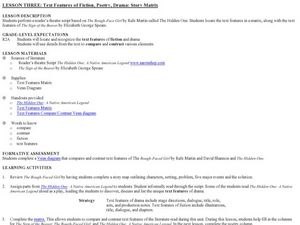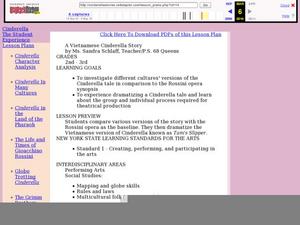Drama Teacher
The 12 Dramatic Elements
Plays are meant to be seen and so are these 12 elements that give plays the dramatic effect. Introduce young actors to these key terms and their explanations
Brigham Young University
Understanding Design, Composition, and Color
The set for a play combines design elements (style, line, shape, mass, measure, position, color, and texture) and principles of composition (unity, harmony, contrast, variation, balance, proportion, and emphasis) to create a particular...
Curated OER
Dusty Locks and the Three Bears
Read this twist on Goldilocks and the Three Bears: Dusty Locks and the Three Bears by Susan Lowell. Kindergartners listen, predict, and discuss the story. They then participate in a dramatization of the story and draw a picture...
Curated OER
Identifying Text Features of a Self-Written Fable
Make learning the parts of a book fun by having pupils construct their own glossary entries, table of contents, and title page. Beginning with a review of text features and a hunt for examples, kids use previously written fables to...
Curated OER
Text Features of Fiction, Poetry, Drama: Story Matrix
How do novels differ from plays? Explore with your class the text features of fiction and drama by reading The Hidden One: Native American Legend and then performing a reader’s theater script based on the story. Class members create a...
Columbus City Schools
Let’s Get Theoretical About Cells
Get up close and personal with cells in a hands-on journey to discover what makes up living things. Scholars learn valuable microscope skills, delve into the Modern Cell Theory, and gain insight into how cells reproduce. The included lab...
Curated OER
Living Yesterday's History Today
Students explore the colonial period to describe and contrast the life and experiences of people who lived at that time with the lives of individual's in the current era. the lives of researched characters are dramatically enacted and...
Curated OER
Characters in Live Performance
Your intermediate or advanced thespians choose dramatic scenes to perform in duos, small groups, or solo to demonstrate vocal and physical characterization. Use class time to prepare and rehearse. Detailed rubrics work for peer assessment.
Curated OER
Dramatizing Tam's Slipper
Students investigate the Japanese version of the Cinderella tale. In this fairy tale lesson, students read Tam's Slipper and construct a Venn diagram to compare and contrast the tale with the American version.
K20 LEARN
Criminal Motivations: Irony and Characterization In "The Cask Of Amontillado"
Edgar Allan Poe's short story "The Cask of Amontillado" is a bit of a puzzle. Critics have long debated Montresor's motives for killing Fortunato. Young scholars examine examples of the three types of irony (verbal, dramatic, and...
Curated OER
Isn't It Ironic?
After examining the definitions of situational, dramatic, and verbal irony viewers are presented with a series of situations and asked to label the type of irony each example represents. The photos alone make this slide show worth a look.
Curated OER
How Tragic!
Tenth graders read and study, in-depth, a specific classical tragedy, in this case, Oedipus. They explore strategies from making meaning out of or interpreting texts, as well as strategies for determining how authors create meaning in...
Curated OER
Born to be Wild
Students watch an episode depicting the human vs. polar bear conflict in Churchill, Canada. They conduct online research and analyze the information. They interpret the facts and use storytelling techniques and role playing to convey...
Hawaiʻi State Department of Education
Comparing Themes
The tale of "Lon Po Po" is a Chinese story, very similar to the European tale of "Little Red Riding Hood." Learners make cross cultural comparisons between the two tales, focusing on themes common to both. They review story elements such...
Curated OER
Living Yesterday's History Today
Learners describe and contrast life as it was in colonial days. They plan, compose, and produce a student movie. They reflect on what they have learned. They share their experience with others in digital format.
Curated OER
Silas Marner by George Eliot
Mary Anne Evans, better known by her pen name George Eliot, wrote Silas Marner in 1861. While you're compiling materials for your Victorian unit, consider printing off these essay questions to help readers really explore the text. Some...
Curated OER
Analyzing Literary Devices
Eighth graders identify figurative language and poetry in this literary analysis lesson. Using Through the Looking Glass by Lewis Carroll and a YouTube video for "The Walrus and the Carpenter," young readers complete a literary device...
Curated OER
Theatre Prop Design and Construction
Fourth graders construct individual props. In this theatrical arts lesson plan, 4th graders use the elements of art to create various props using paper mache. Students construct objects such as logs, fruit, and a picture frame.
Curated OER
Nature’s Fury—Myths and Drama
Fifth graders explore the elements of theatre. For this dramatic performances lesson, 5th graders discuss the structural elements of theatre and dramatize "The Origins of the Season," an explanation myth.
Curated OER
It's All in the Translation
Students compare and contrast translations of Greek literature. In this dramatic literature instructional activity, students read and perform passages from four different translations of Euripides's Hecuba. Students discuss how the...
Curated OER
Identifying and Describing Story Elements
First graders examine how to identify the different elements of a story and how they fit in a definite sequence. The use of comprehension skills is essential to retell the story as desired within the lesson.
Curated OER
So Foul and Fair a Play
Students watch various interpretations of Shakespeare's Macbeth in film. In groups, they examine the setting, characters, music and sequence. They compare and contrast the various films and discuss the differences. They write an essay on...
Curated OER
Comparing Tales through Performance
Young scholars compare and contrast versions of The Three Little Pigs. In this fairy tale lesson, students read 3 versions of the fairy tale and dramatize them in order to analyze the similarities and differences.
Curated OER
Watch Your Conductor Like a Hawk
Students focus their eyes on the conductor in music class. The teacher uses a music sheet to isolate the musical elements of tempo, balance, and blend.























